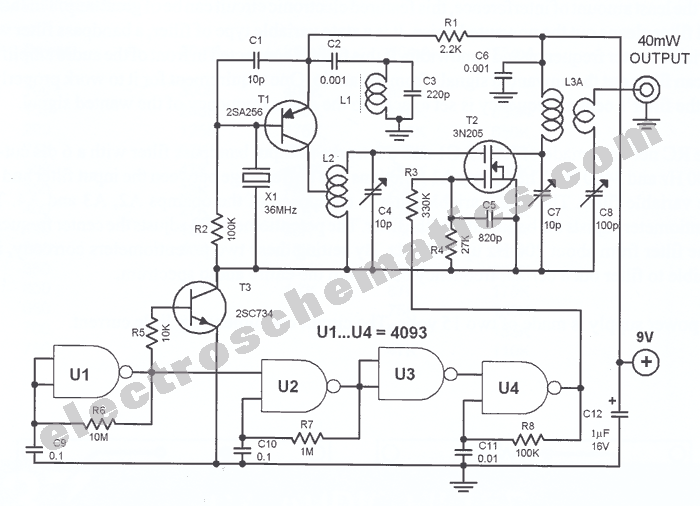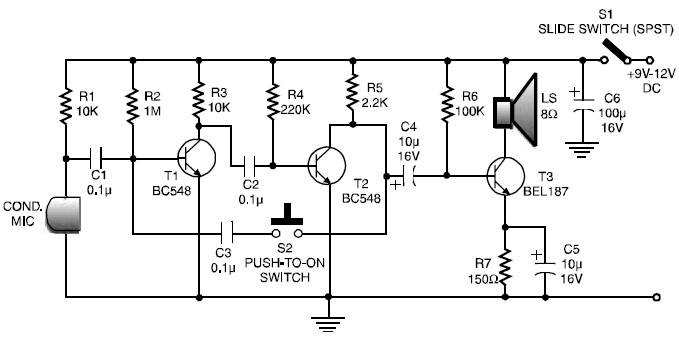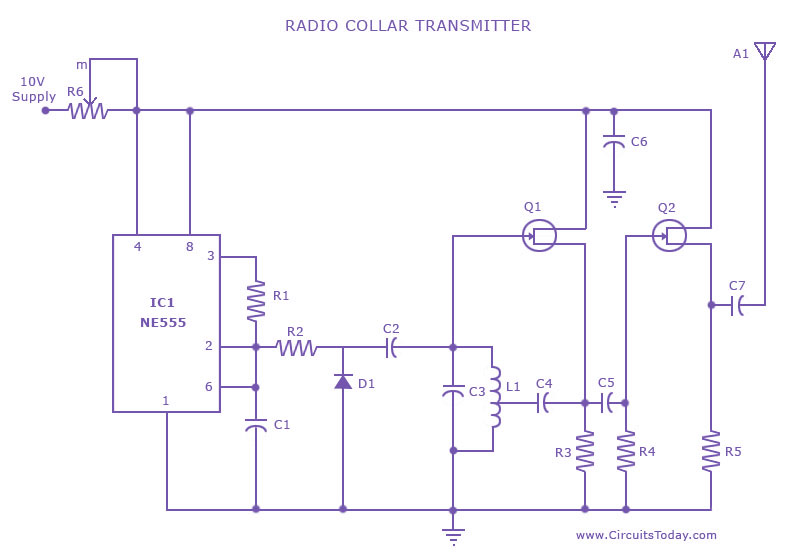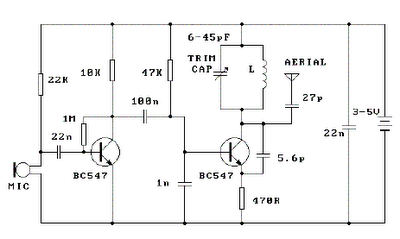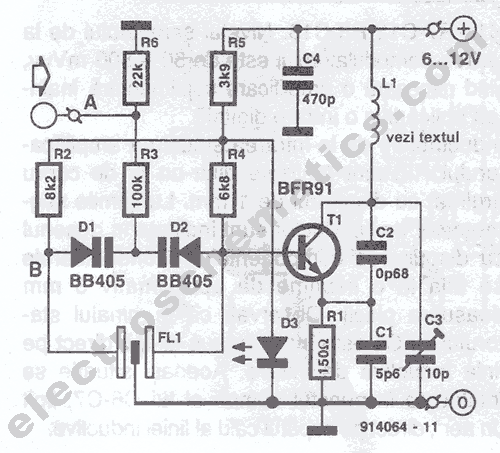
Simple FM Transmitter Bug
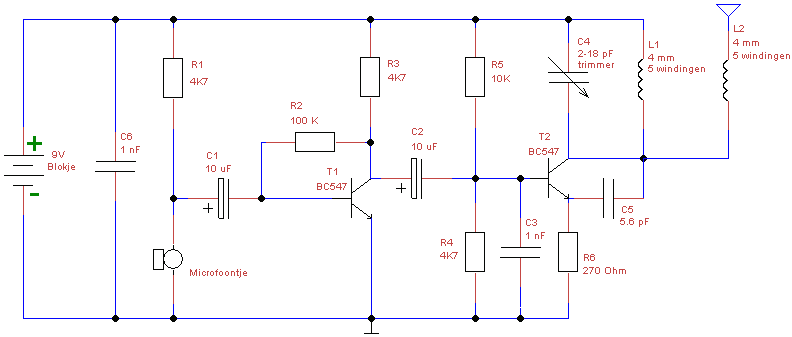
This is a simple design of a small FM transmitter bug that is ideal for transmitting and eavesdropping purposes. Due to its high sensitivity, it can even pick up the ticking of a clock. The estimated range is approximately 50 meters, and a small piece of wire serves as an antenna, allowing coverage of an entire house. L1 and L2 are two identical air coils, each consisting of 5 turns with a diameter of about 4 mm. The wire thickness is not critical, and 0.5 mm wire works effectively. C4 is used for frequency adjustment. To tune, set an FM radio to an empty frequency in the FM band and adjust C4 until silence is achieved or a whistle is heard. This allows for precise tuning of the radio and the transmitter installed in a room for interception. Note: Due to the inherent instability of these transmitter bugs, it is advisable to keep the component leads short and the circuit mechanically secure. Additionally, placing a 1 nF capacitor (C6) will enhance stability. The components include R1, R3, R4: 4.7kΩ; R2: 100kΩ; R5: 10kΩ; R6: 270Ω; C1, C2: 10µF; C3, C6: 1nF; C4: 2-18pF trimmer; C5: 5.6pF; L1, L2: air coil windings with a diameter of 4 mm; T1, T2: BC547 transistors; and a condenser microphone.
The FM transmitter bug circuit is designed to operate efficiently within the specified parameters. The use of air coils L1 and L2, constructed with five turns of wire, creates an inductor that is crucial for the oscillator's function. The diameter of the coils being approximately 4 mm helps ensure that the inductance is suitable for the desired frequency range. The choice of wire thickness, while flexible, can influence the resistance and thus the overall performance of the transmitter.
The component values are critical for achieving the desired frequency modulation. The resistors R1, R3, and R4, each at 4.7kΩ, help to set the biasing conditions for the transistors T1 and T2, which amplify the audio signal captured by the condenser microphone. The 100kΩ resistor (R2) plays a role in the input impedance, allowing for efficient signal coupling from the microphone to the amplifier stage. The 10kΩ resistor (R5) is used for feedback, which stabilizes the gain of the amplifier.
Capacitors C1 and C2, each rated at 10µF, serve as coupling capacitors, allowing AC signals to pass while blocking DC components. The 1nF capacitors (C3 and C6) are essential for frequency stability and filtering, ensuring that the transmitter operates within the intended frequency band without unwanted oscillations. The trimmer capacitor (C4) provides fine-tuning capability, allowing the user to adjust the transmission frequency precisely to avoid interference with other radio signals.
Overall, this circuit is a compact and effective solution for FM transmission, suitable for various applications, including audio transmission and surveillance. Proper assembly and component selection are essential to ensure reliable operation and optimal performance of the transmitter bug.This is a simple design of a small FM Transmitter Bug that`s perfect for transmitting and eavesdropping purposes. Due to the high sensitivity, even the ticking of the clock to hear. The range is estimated at anything from 50 meters. With a small piece of wire as an antenna to get at least the whole house. L1 and L2 are two equal air pools. They ea ch consist of 5 turns at a diameter of about 4 mm. The thickness of the wire does not matter, 0. 5 mm works perfectly. C4 is the frequency adjustment. Tune an FM radio in an empty area of the FM band and C4 to turn your silence or hear a whistle. From what you can precisely adjust the radio and the transmitter installed in a room somewhere to intercept. Note: Because these transmitter bugs inherently unstable, you better read the short legs of the components keep the circuit mechanically tightly together up.
Also placing a 1 nF capacitor (C6) will benefit stability. R1, R3, R4: 4K7 R2: 100K R5: 10K R6: 270 Ohms C1, C2: 10 uF C3, C6: 1 nF C4: 2-18 pF trimmer C5: 5. 6 pF L1, L2: air puddle windings on May 4 mm in diameter (see text) T1, T2: 547 BC Condenser microphone Original Text: Ook het plaatsen van een 1 nF condensatortje (C6) over de voedingsaanluitingen komt de werking ten goede. 🔗 External reference
The FM transmitter bug circuit is designed to operate efficiently within the specified parameters. The use of air coils L1 and L2, constructed with five turns of wire, creates an inductor that is crucial for the oscillator's function. The diameter of the coils being approximately 4 mm helps ensure that the inductance is suitable for the desired frequency range. The choice of wire thickness, while flexible, can influence the resistance and thus the overall performance of the transmitter.
The component values are critical for achieving the desired frequency modulation. The resistors R1, R3, and R4, each at 4.7kΩ, help to set the biasing conditions for the transistors T1 and T2, which amplify the audio signal captured by the condenser microphone. The 100kΩ resistor (R2) plays a role in the input impedance, allowing for efficient signal coupling from the microphone to the amplifier stage. The 10kΩ resistor (R5) is used for feedback, which stabilizes the gain of the amplifier.
Capacitors C1 and C2, each rated at 10µF, serve as coupling capacitors, allowing AC signals to pass while blocking DC components. The 1nF capacitors (C3 and C6) are essential for frequency stability and filtering, ensuring that the transmitter operates within the intended frequency band without unwanted oscillations. The trimmer capacitor (C4) provides fine-tuning capability, allowing the user to adjust the transmission frequency precisely to avoid interference with other radio signals.
Overall, this circuit is a compact and effective solution for FM transmission, suitable for various applications, including audio transmission and surveillance. Proper assembly and component selection are essential to ensure reliable operation and optimal performance of the transmitter bug.This is a simple design of a small FM Transmitter Bug that`s perfect for transmitting and eavesdropping purposes. Due to the high sensitivity, even the ticking of the clock to hear. The range is estimated at anything from 50 meters. With a small piece of wire as an antenna to get at least the whole house. L1 and L2 are two equal air pools. They ea ch consist of 5 turns at a diameter of about 4 mm. The thickness of the wire does not matter, 0. 5 mm works perfectly. C4 is the frequency adjustment. Tune an FM radio in an empty area of the FM band and C4 to turn your silence or hear a whistle. From what you can precisely adjust the radio and the transmitter installed in a room somewhere to intercept. Note: Because these transmitter bugs inherently unstable, you better read the short legs of the components keep the circuit mechanically tightly together up.
Also placing a 1 nF capacitor (C6) will benefit stability. R1, R3, R4: 4K7 R2: 100K R5: 10K R6: 270 Ohms C1, C2: 10 uF C3, C6: 1 nF C4: 2-18 pF trimmer C5: 5. 6 pF L1, L2: air puddle windings on May 4 mm in diameter (see text) T1, T2: 547 BC Condenser microphone Original Text: Ook het plaatsen van een 1 nF condensatortje (C6) over de voedingsaanluitingen komt de werking ten goede. 🔗 External reference
